UWS Construction Technology Assignment: Heat Transfer Principles
VerifiedAdded on 2023/01/23
|10
|1802
|98
Homework Assignment
AI Summary
This assignment solution addresses heat transfer principles within the context of construction technology. It begins by explaining how the human body gains and loses heat through radiation, evaporation, convection, and conduction. The solution then analyzes heat loss in an uninsulated brick veneer house in Sydney during winter, using a sectional diagram to illustrate the paths of heat transfer. A calculation of thermal conductance (U-value) for a cavity wall is presented, considering brickwork, a cavity, and studwork with plasterboard. The assignment also explores methods for passive cooling through air movement, breezes, and evaporative cooling, as well as the use of integrated louvers for daylighting and solar heat management. The solution incorporates relevant references to support the analysis.

CONSTRUCTION TECHNOLOGY 5
By Name
Course
Instructor
Institution
Location
Date
By Name
Course
Instructor
Institution
Location
Date
Paraphrase This Document
Need a fresh take? Get an instant paraphrase of this document with our AI Paraphraser
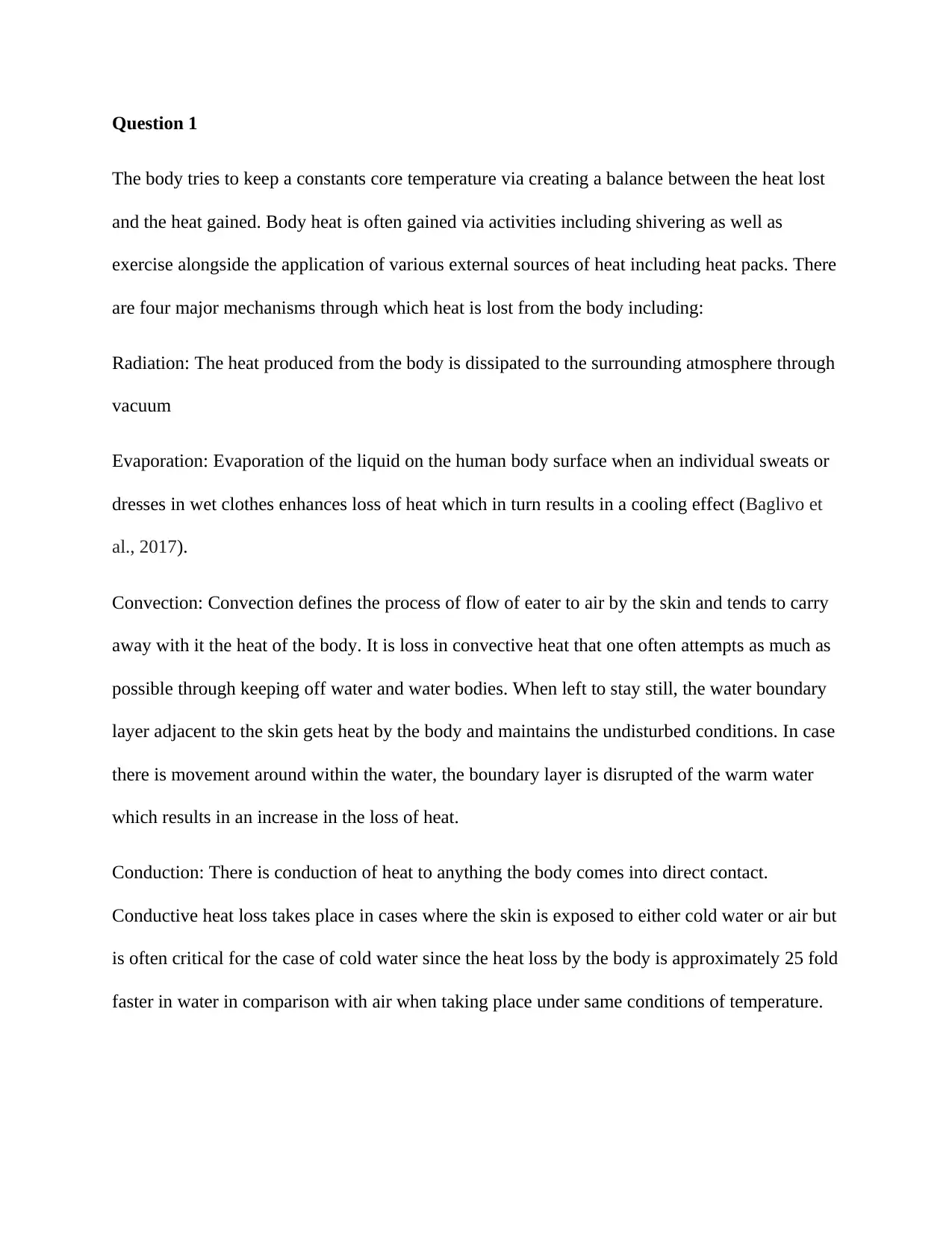
Question 1
The body tries to keep a constants core temperature via creating a balance between the heat lost
and the heat gained. Body heat is often gained via activities including shivering as well as
exercise alongside the application of various external sources of heat including heat packs. There
are four major mechanisms through which heat is lost from the body including:
Radiation: The heat produced from the body is dissipated to the surrounding atmosphere through
vacuum
Evaporation: Evaporation of the liquid on the human body surface when an individual sweats or
dresses in wet clothes enhances loss of heat which in turn results in a cooling effect (Baglivo et
al., 2017).
Convection: Convection defines the process of flow of eater to air by the skin and tends to carry
away with it the heat of the body. It is loss in convective heat that one often attempts as much as
possible through keeping off water and water bodies. When left to stay still, the water boundary
layer adjacent to the skin gets heat by the body and maintains the undisturbed conditions. In case
there is movement around within the water, the boundary layer is disrupted of the warm water
which results in an increase in the loss of heat.
Conduction: There is conduction of heat to anything the body comes into direct contact.
Conductive heat loss takes place in cases where the skin is exposed to either cold water or air but
is often critical for the case of cold water since the heat loss by the body is approximately 25 fold
faster in water in comparison with air when taking place under same conditions of temperature.
The body tries to keep a constants core temperature via creating a balance between the heat lost
and the heat gained. Body heat is often gained via activities including shivering as well as
exercise alongside the application of various external sources of heat including heat packs. There
are four major mechanisms through which heat is lost from the body including:
Radiation: The heat produced from the body is dissipated to the surrounding atmosphere through
vacuum
Evaporation: Evaporation of the liquid on the human body surface when an individual sweats or
dresses in wet clothes enhances loss of heat which in turn results in a cooling effect (Baglivo et
al., 2017).
Convection: Convection defines the process of flow of eater to air by the skin and tends to carry
away with it the heat of the body. It is loss in convective heat that one often attempts as much as
possible through keeping off water and water bodies. When left to stay still, the water boundary
layer adjacent to the skin gets heat by the body and maintains the undisturbed conditions. In case
there is movement around within the water, the boundary layer is disrupted of the warm water
which results in an increase in the loss of heat.
Conduction: There is conduction of heat to anything the body comes into direct contact.
Conductive heat loss takes place in cases where the skin is exposed to either cold water or air but
is often critical for the case of cold water since the heat loss by the body is approximately 25 fold
faster in water in comparison with air when taking place under same conditions of temperature.
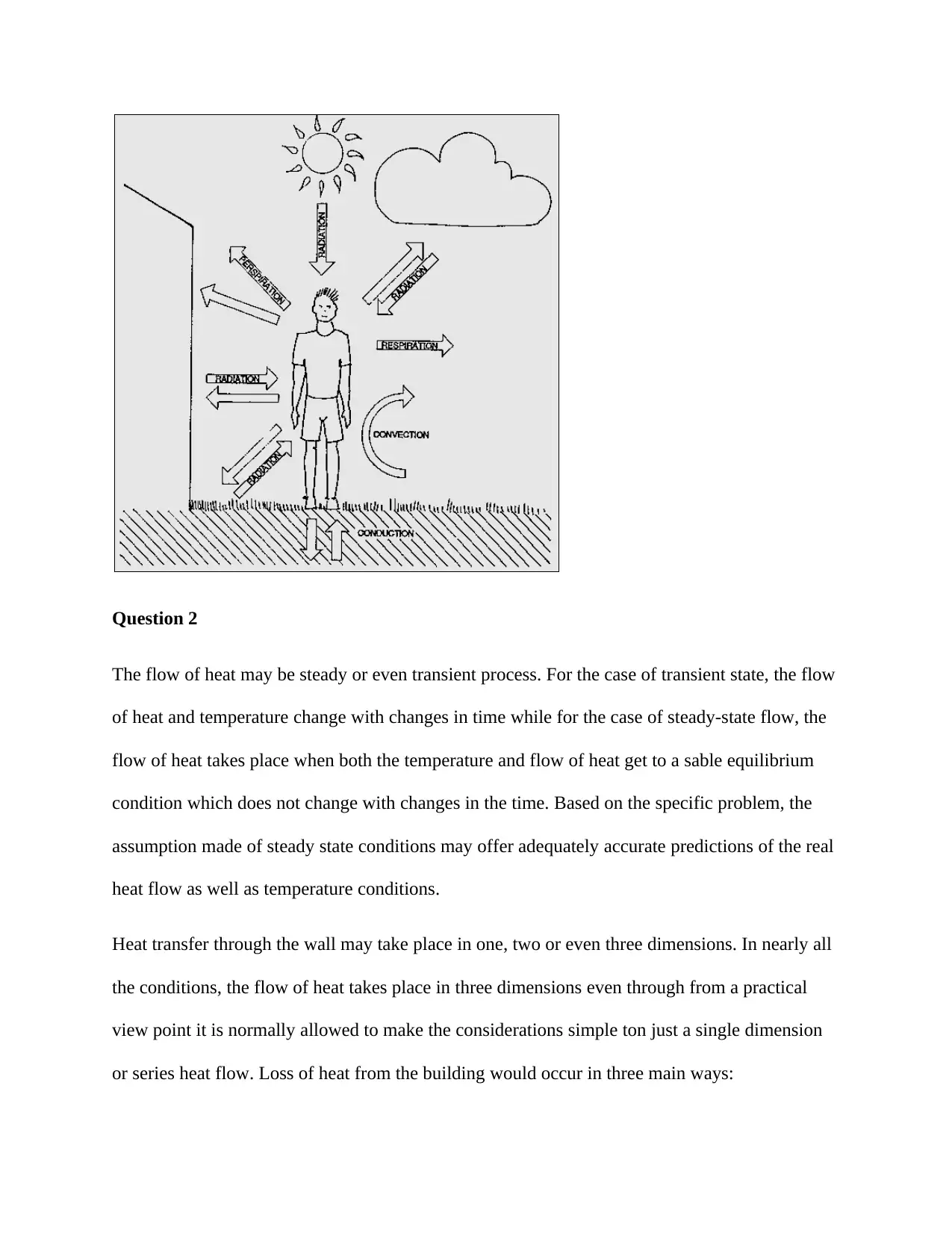
Question 2
The flow of heat may be steady or even transient process. For the case of transient state, the flow
of heat and temperature change with changes in time while for the case of steady-state flow, the
flow of heat takes place when both the temperature and flow of heat get to a sable equilibrium
condition which does not change with changes in the time. Based on the specific problem, the
assumption made of steady state conditions may offer adequately accurate predictions of the real
heat flow as well as temperature conditions.
Heat transfer through the wall may take place in one, two or even three dimensions. In nearly all
the conditions, the flow of heat takes place in three dimensions even through from a practical
view point it is normally allowed to make the considerations simple ton just a single dimension
or series heat flow. Loss of heat from the building would occur in three main ways:
The flow of heat may be steady or even transient process. For the case of transient state, the flow
of heat and temperature change with changes in time while for the case of steady-state flow, the
flow of heat takes place when both the temperature and flow of heat get to a sable equilibrium
condition which does not change with changes in the time. Based on the specific problem, the
assumption made of steady state conditions may offer adequately accurate predictions of the real
heat flow as well as temperature conditions.
Heat transfer through the wall may take place in one, two or even three dimensions. In nearly all
the conditions, the flow of heat takes place in three dimensions even through from a practical
view point it is normally allowed to make the considerations simple ton just a single dimension
or series heat flow. Loss of heat from the building would occur in three main ways:
⊘ This is a preview!⊘
Do you want full access?
Subscribe today to unlock all pages.

Trusted by 1+ million students worldwide
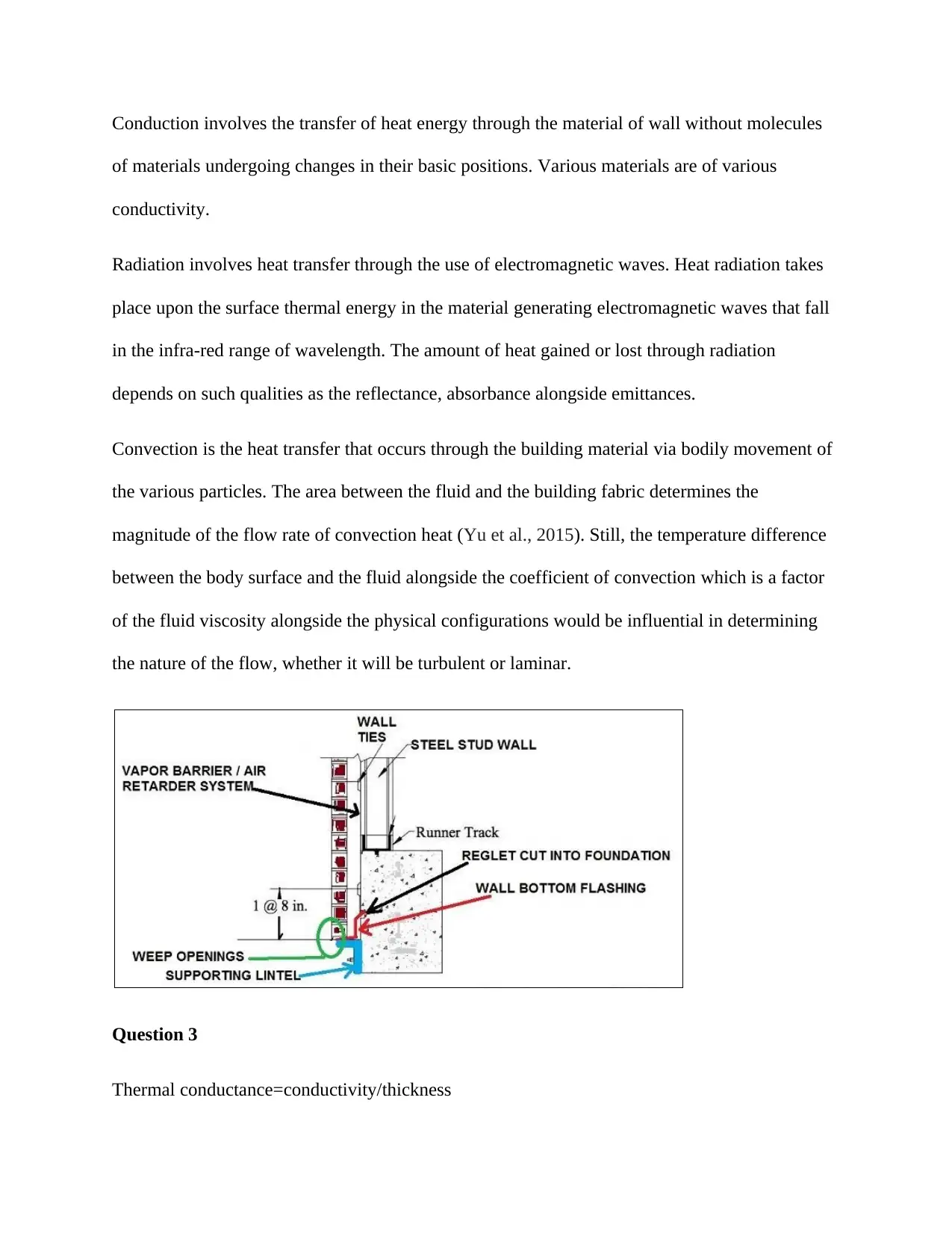
Conduction involves the transfer of heat energy through the material of wall without molecules
of materials undergoing changes in their basic positions. Various materials are of various
conductivity.
Radiation involves heat transfer through the use of electromagnetic waves. Heat radiation takes
place upon the surface thermal energy in the material generating electromagnetic waves that fall
in the infra-red range of wavelength. The amount of heat gained or lost through radiation
depends on such qualities as the reflectance, absorbance alongside emittances.
Convection is the heat transfer that occurs through the building material via bodily movement of
the various particles. The area between the fluid and the building fabric determines the
magnitude of the flow rate of convection heat (Yu et al., 2015). Still, the temperature difference
between the body surface and the fluid alongside the coefficient of convection which is a factor
of the fluid viscosity alongside the physical configurations would be influential in determining
the nature of the flow, whether it will be turbulent or laminar.
Question 3
Thermal conductance=conductivity/thickness
of materials undergoing changes in their basic positions. Various materials are of various
conductivity.
Radiation involves heat transfer through the use of electromagnetic waves. Heat radiation takes
place upon the surface thermal energy in the material generating electromagnetic waves that fall
in the infra-red range of wavelength. The amount of heat gained or lost through radiation
depends on such qualities as the reflectance, absorbance alongside emittances.
Convection is the heat transfer that occurs through the building material via bodily movement of
the various particles. The area between the fluid and the building fabric determines the
magnitude of the flow rate of convection heat (Yu et al., 2015). Still, the temperature difference
between the body surface and the fluid alongside the coefficient of convection which is a factor
of the fluid viscosity alongside the physical configurations would be influential in determining
the nature of the flow, whether it will be turbulent or laminar.
Question 3
Thermal conductance=conductivity/thickness
Paraphrase This Document
Need a fresh take? Get an instant paraphrase of this document with our AI Paraphraser
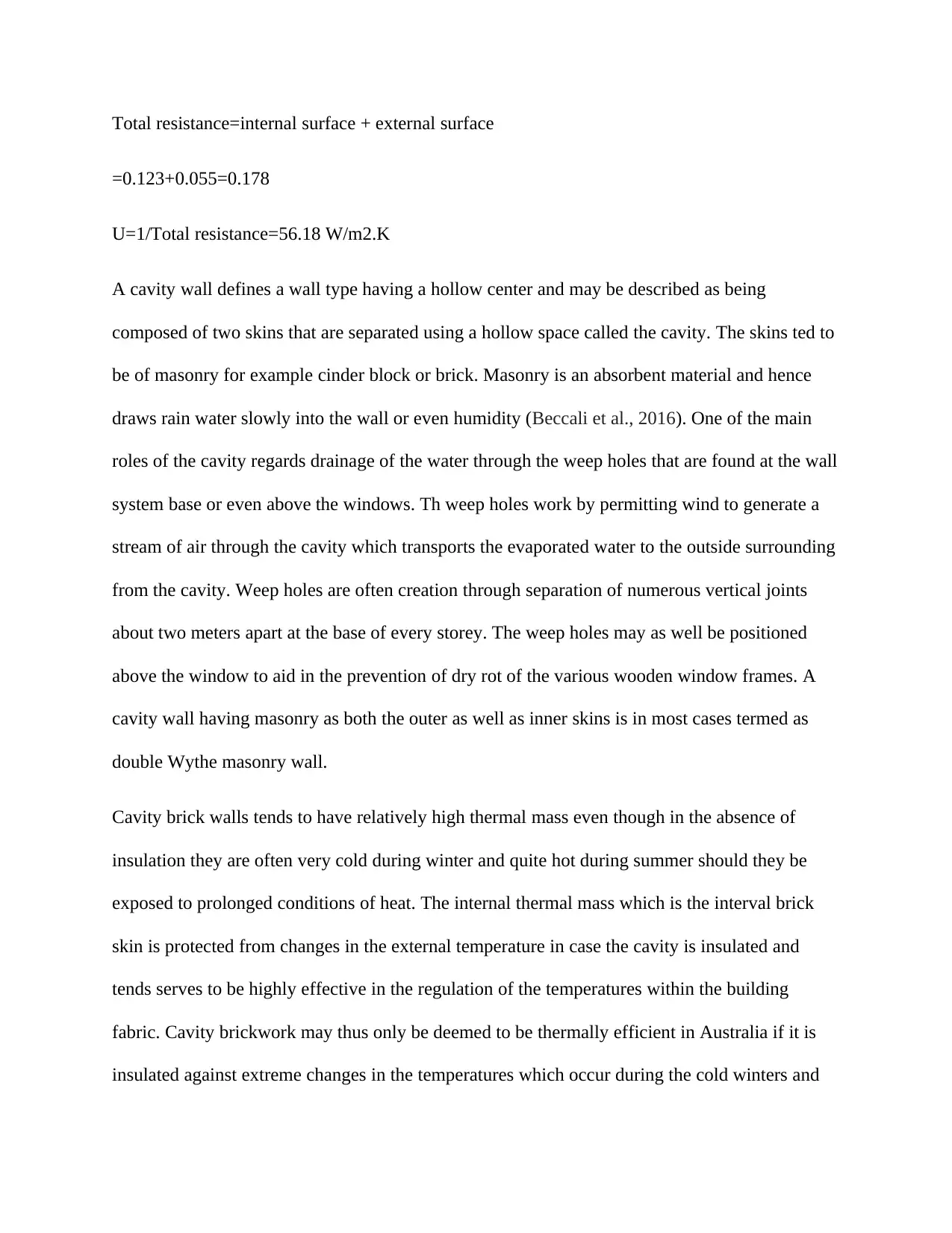
Total resistance=internal surface + external surface
=0.123+0.055=0.178
U=1/Total resistance=56.18 W/m2.K
A cavity wall defines a wall type having a hollow center and may be described as being
composed of two skins that are separated using a hollow space called the cavity. The skins ted to
be of masonry for example cinder block or brick. Masonry is an absorbent material and hence
draws rain water slowly into the wall or even humidity (Beccali et al., 2016). One of the main
roles of the cavity regards drainage of the water through the weep holes that are found at the wall
system base or even above the windows. Th weep holes work by permitting wind to generate a
stream of air through the cavity which transports the evaporated water to the outside surrounding
from the cavity. Weep holes are often creation through separation of numerous vertical joints
about two meters apart at the base of every storey. The weep holes may as well be positioned
above the window to aid in the prevention of dry rot of the various wooden window frames. A
cavity wall having masonry as both the outer as well as inner skins is in most cases termed as
double Wythe masonry wall.
Cavity brick walls tends to have relatively high thermal mass even though in the absence of
insulation they are often very cold during winter and quite hot during summer should they be
exposed to prolonged conditions of heat. The internal thermal mass which is the interval brick
skin is protected from changes in the external temperature in case the cavity is insulated and
tends serves to be highly effective in the regulation of the temperatures within the building
fabric. Cavity brickwork may thus only be deemed to be thermally efficient in Australia if it is
insulated against extreme changes in the temperatures which occur during the cold winters and
=0.123+0.055=0.178
U=1/Total resistance=56.18 W/m2.K
A cavity wall defines a wall type having a hollow center and may be described as being
composed of two skins that are separated using a hollow space called the cavity. The skins ted to
be of masonry for example cinder block or brick. Masonry is an absorbent material and hence
draws rain water slowly into the wall or even humidity (Beccali et al., 2016). One of the main
roles of the cavity regards drainage of the water through the weep holes that are found at the wall
system base or even above the windows. Th weep holes work by permitting wind to generate a
stream of air through the cavity which transports the evaporated water to the outside surrounding
from the cavity. Weep holes are often creation through separation of numerous vertical joints
about two meters apart at the base of every storey. The weep holes may as well be positioned
above the window to aid in the prevention of dry rot of the various wooden window frames. A
cavity wall having masonry as both the outer as well as inner skins is in most cases termed as
double Wythe masonry wall.
Cavity brick walls tends to have relatively high thermal mass even though in the absence of
insulation they are often very cold during winter and quite hot during summer should they be
exposed to prolonged conditions of heat. The internal thermal mass which is the interval brick
skin is protected from changes in the external temperature in case the cavity is insulated and
tends serves to be highly effective in the regulation of the temperatures within the building
fabric. Cavity brickwork may thus only be deemed to be thermally efficient in Australia if it is
insulated against extreme changes in the temperatures which occur during the cold winters and
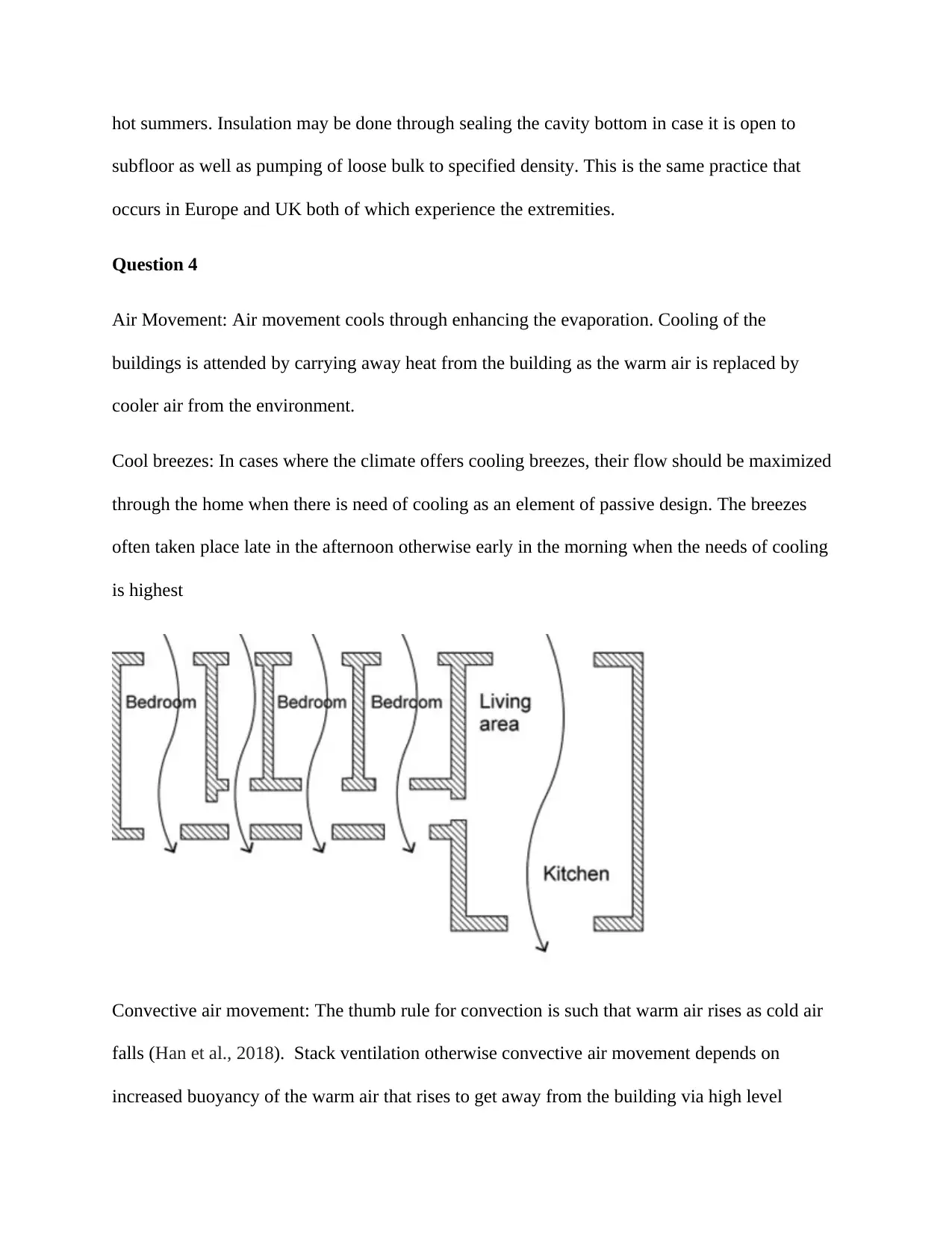
hot summers. Insulation may be done through sealing the cavity bottom in case it is open to
subfloor as well as pumping of loose bulk to specified density. This is the same practice that
occurs in Europe and UK both of which experience the extremities.
Question 4
Air Movement: Air movement cools through enhancing the evaporation. Cooling of the
buildings is attended by carrying away heat from the building as the warm air is replaced by
cooler air from the environment.
Cool breezes: In cases where the climate offers cooling breezes, their flow should be maximized
through the home when there is need of cooling as an element of passive design. The breezes
often taken place late in the afternoon otherwise early in the morning when the needs of cooling
is highest
Convective air movement: The thumb rule for convection is such that warm air rises as cold air
falls (Han et al., 2018). Stack ventilation otherwise convective air movement depends on
increased buoyancy of the warm air that rises to get away from the building via high level
subfloor as well as pumping of loose bulk to specified density. This is the same practice that
occurs in Europe and UK both of which experience the extremities.
Question 4
Air Movement: Air movement cools through enhancing the evaporation. Cooling of the
buildings is attended by carrying away heat from the building as the warm air is replaced by
cooler air from the environment.
Cool breezes: In cases where the climate offers cooling breezes, their flow should be maximized
through the home when there is need of cooling as an element of passive design. The breezes
often taken place late in the afternoon otherwise early in the morning when the needs of cooling
is highest
Convective air movement: The thumb rule for convection is such that warm air rises as cold air
falls (Han et al., 2018). Stack ventilation otherwise convective air movement depends on
increased buoyancy of the warm air that rises to get away from the building via high level
⊘ This is a preview!⊘
Do you want full access?
Subscribe today to unlock all pages.

Trusted by 1+ million students worldwide
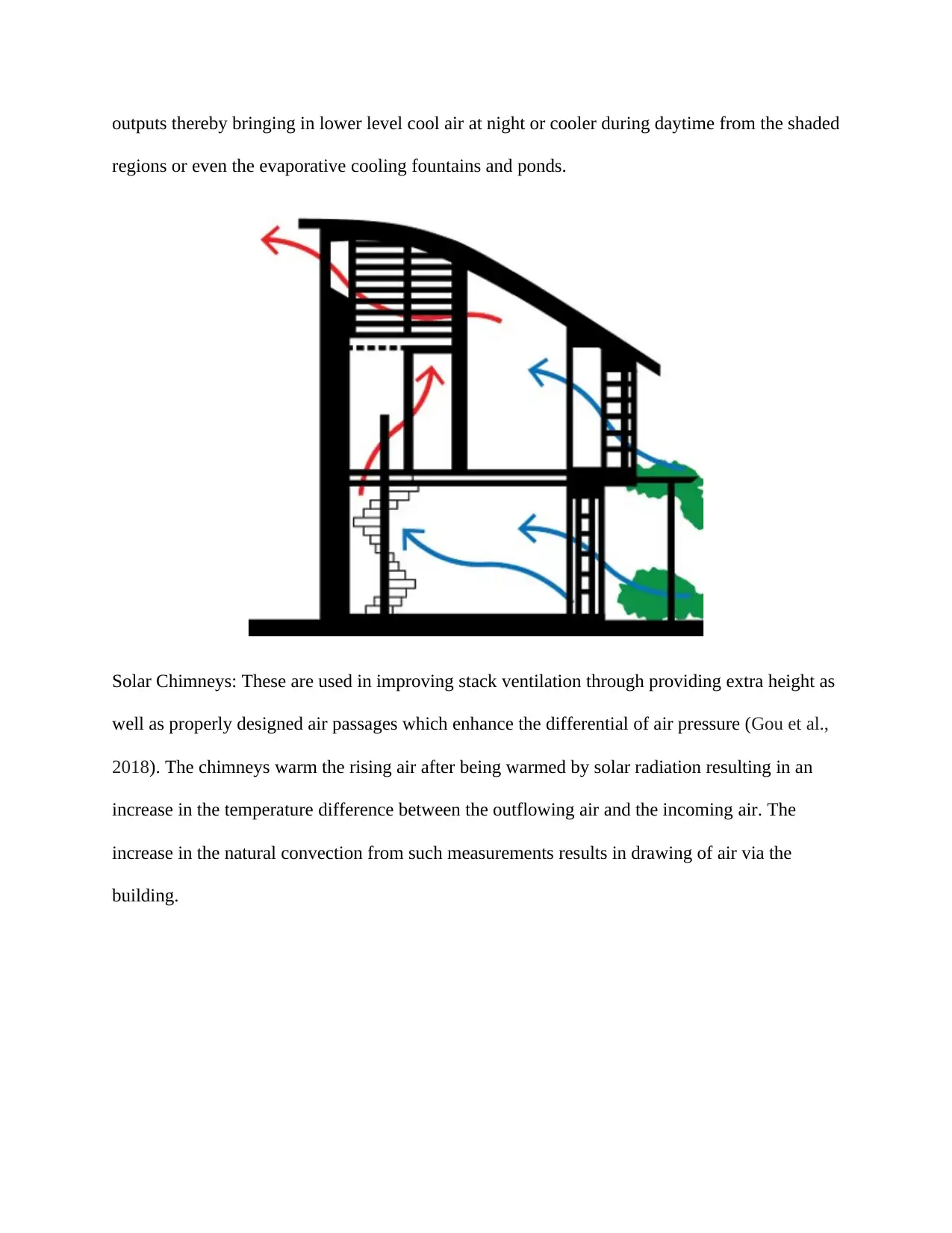
outputs thereby bringing in lower level cool air at night or cooler during daytime from the shaded
regions or even the evaporative cooling fountains and ponds.
Solar Chimneys: These are used in improving stack ventilation through providing extra height as
well as properly designed air passages which enhance the differential of air pressure (Gou et al.,
2018). The chimneys warm the rising air after being warmed by solar radiation resulting in an
increase in the temperature difference between the outflowing air and the incoming air. The
increase in the natural convection from such measurements results in drawing of air via the
building.
regions or even the evaporative cooling fountains and ponds.
Solar Chimneys: These are used in improving stack ventilation through providing extra height as
well as properly designed air passages which enhance the differential of air pressure (Gou et al.,
2018). The chimneys warm the rising air after being warmed by solar radiation resulting in an
increase in the temperature difference between the outflowing air and the incoming air. The
increase in the natural convection from such measurements results in drawing of air via the
building.
Paraphrase This Document
Need a fresh take? Get an instant paraphrase of this document with our AI Paraphraser

Evaporative cooling: Large volumes of heat are drawn from the surrounding air as the water
undergoes evaporation hence rendering evaporation an effective method of passive cooling even
though it works sufficiently at humidity levels that are lower than 70% since at such, the air has
enhanced capacity in taking up water vapor (Fernandes et al., 2019).
Question 5
Diffused daylighting results in uniform as well as consistent lighting and aids in ensuring the
daylight is a primary illumination source. Integrated louvers are one such effective way of
management of solar heat gain as well as sunlight. The louvers will be hermetically sealed glass
units which join louvers within the glass for use in exterior glazing applications. Integrated
operable louvers provide flexible heat as well as light control besides managing the quantity as
well as quality of transmission of light via fenestration (Echenagucia et al., 2015).
undergoes evaporation hence rendering evaporation an effective method of passive cooling even
though it works sufficiently at humidity levels that are lower than 70% since at such, the air has
enhanced capacity in taking up water vapor (Fernandes et al., 2019).
Question 5
Diffused daylighting results in uniform as well as consistent lighting and aids in ensuring the
daylight is a primary illumination source. Integrated louvers are one such effective way of
management of solar heat gain as well as sunlight. The louvers will be hermetically sealed glass
units which join louvers within the glass for use in exterior glazing applications. Integrated
operable louvers provide flexible heat as well as light control besides managing the quantity as
well as quality of transmission of light via fenestration (Echenagucia et al., 2015).
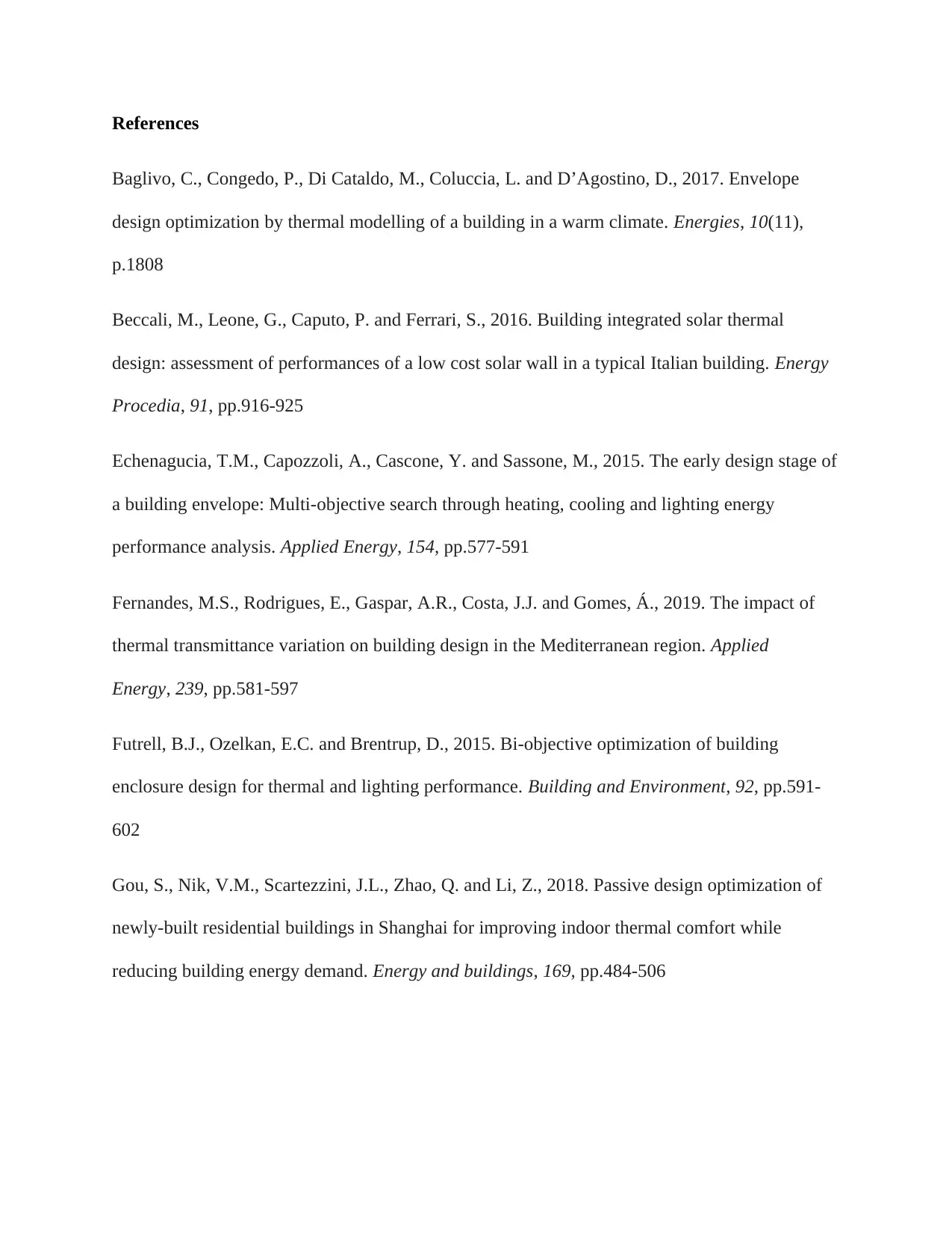
References
Baglivo, C., Congedo, P., Di Cataldo, M., Coluccia, L. and D’Agostino, D., 2017. Envelope
design optimization by thermal modelling of a building in a warm climate. Energies, 10(11),
p.1808
Beccali, M., Leone, G., Caputo, P. and Ferrari, S., 2016. Building integrated solar thermal
design: assessment of performances of a low cost solar wall in a typical Italian building. Energy
Procedia, 91, pp.916-925
Echenagucia, T.M., Capozzoli, A., Cascone, Y. and Sassone, M., 2015. The early design stage of
a building envelope: Multi-objective search through heating, cooling and lighting energy
performance analysis. Applied Energy, 154, pp.577-591
Fernandes, M.S., Rodrigues, E., Gaspar, A.R., Costa, J.J. and Gomes, Á., 2019. The impact of
thermal transmittance variation on building design in the Mediterranean region. Applied
Energy, 239, pp.581-597
Futrell, B.J., Ozelkan, E.C. and Brentrup, D., 2015. Bi-objective optimization of building
enclosure design for thermal and lighting performance. Building and Environment, 92, pp.591-
602
Gou, S., Nik, V.M., Scartezzini, J.L., Zhao, Q. and Li, Z., 2018. Passive design optimization of
newly-built residential buildings in Shanghai for improving indoor thermal comfort while
reducing building energy demand. Energy and buildings, 169, pp.484-506
Baglivo, C., Congedo, P., Di Cataldo, M., Coluccia, L. and D’Agostino, D., 2017. Envelope
design optimization by thermal modelling of a building in a warm climate. Energies, 10(11),
p.1808
Beccali, M., Leone, G., Caputo, P. and Ferrari, S., 2016. Building integrated solar thermal
design: assessment of performances of a low cost solar wall in a typical Italian building. Energy
Procedia, 91, pp.916-925
Echenagucia, T.M., Capozzoli, A., Cascone, Y. and Sassone, M., 2015. The early design stage of
a building envelope: Multi-objective search through heating, cooling and lighting energy
performance analysis. Applied Energy, 154, pp.577-591
Fernandes, M.S., Rodrigues, E., Gaspar, A.R., Costa, J.J. and Gomes, Á., 2019. The impact of
thermal transmittance variation on building design in the Mediterranean region. Applied
Energy, 239, pp.581-597
Futrell, B.J., Ozelkan, E.C. and Brentrup, D., 2015. Bi-objective optimization of building
enclosure design for thermal and lighting performance. Building and Environment, 92, pp.591-
602
Gou, S., Nik, V.M., Scartezzini, J.L., Zhao, Q. and Li, Z., 2018. Passive design optimization of
newly-built residential buildings in Shanghai for improving indoor thermal comfort while
reducing building energy demand. Energy and buildings, 169, pp.484-506
⊘ This is a preview!⊘
Do you want full access?
Subscribe today to unlock all pages.

Trusted by 1+ million students worldwide
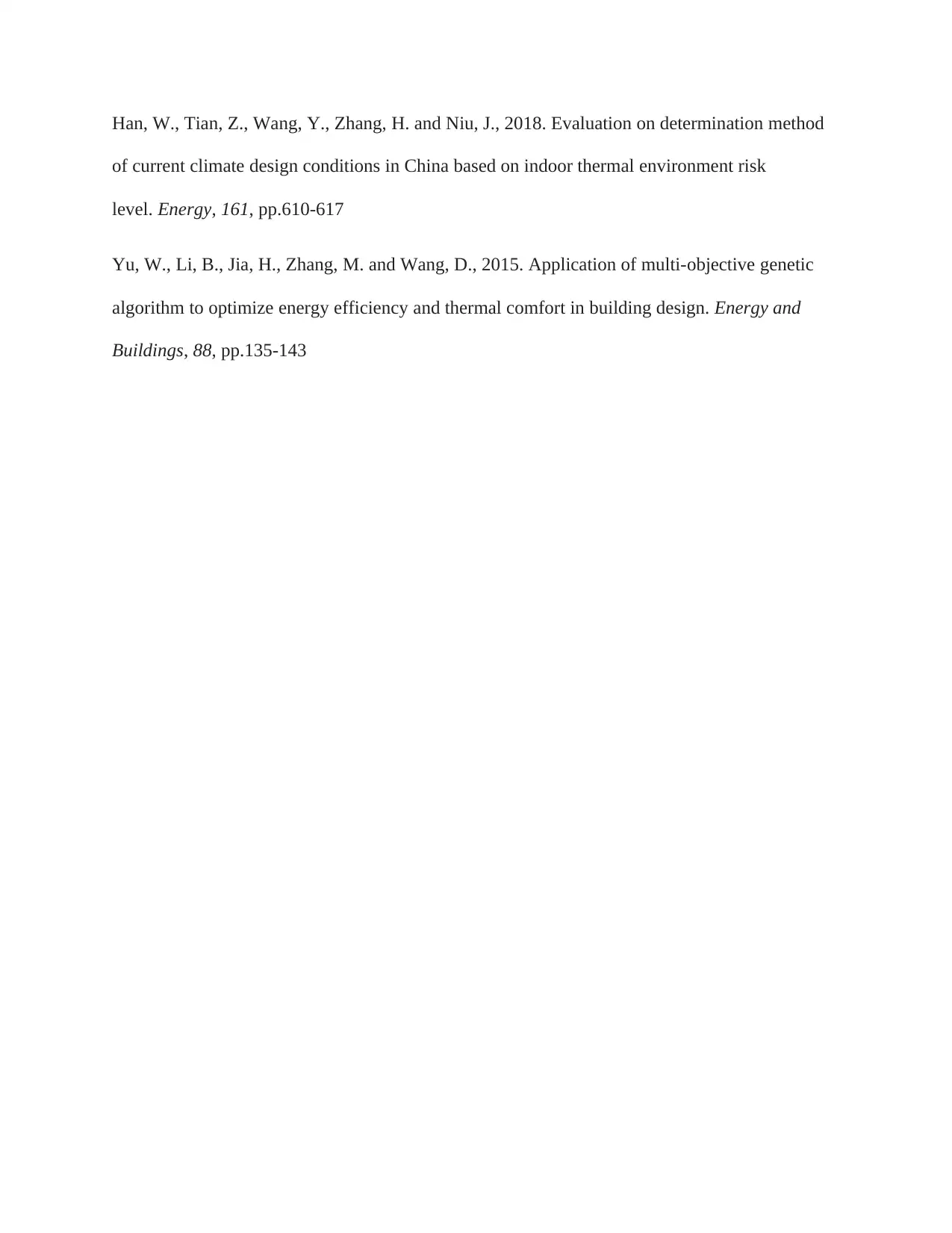
Han, W., Tian, Z., Wang, Y., Zhang, H. and Niu, J., 2018. Evaluation on determination method
of current climate design conditions in China based on indoor thermal environment risk
level. Energy, 161, pp.610-617
Yu, W., Li, B., Jia, H., Zhang, M. and Wang, D., 2015. Application of multi-objective genetic
algorithm to optimize energy efficiency and thermal comfort in building design. Energy and
Buildings, 88, pp.135-143
of current climate design conditions in China based on indoor thermal environment risk
level. Energy, 161, pp.610-617
Yu, W., Li, B., Jia, H., Zhang, M. and Wang, D., 2015. Application of multi-objective genetic
algorithm to optimize energy efficiency and thermal comfort in building design. Energy and
Buildings, 88, pp.135-143
1 out of 10
Related Documents
Your All-in-One AI-Powered Toolkit for Academic Success.
+13062052269
info@desklib.com
Available 24*7 on WhatsApp / Email
![[object Object]](/_next/static/media/star-bottom.7253800d.svg)
Unlock your academic potential
Copyright © 2020–2025 A2Z Services. All Rights Reserved. Developed and managed by ZUCOL.





